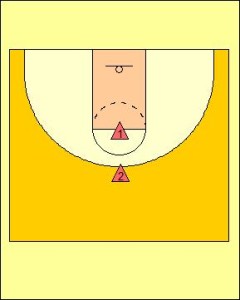An Analysis of Defensive Transition: Featuring the Triangle and i-formation
Right from the start of basketball coaching it will become evident that a team’s Defensive Transition will be vital to ongoing and lasting success. At the very junior levels, many of the points that are scored during games will be as a result of the fast break or offensive transition phases. When looking at the junior representative level the emphasis on a quick flowing transition increases in focus so the tempo of a team’s offense can quicken to become more efficient and effective. Then at the senior or elite levels of basketball players are more aggressive and very comfortable with try to capitalise on a number advantage. Therefore, in all situations the Defensive transition of a team can be significant in limiting the options presented to an opposition in broken play.
There are a number of different defensive transition systems that can be implemented. However, more important than just choosing a system is for a coach to think about what the needs of their team are. By doing this a coach can make the strategy fit the need and in so doing will find the most efficient and effective option.
There are two different elements to be discussed in this article. The first is offensive rebounding and second element will be the transition coverage. Offensive rebounding can be described by the number and structure of this element. While transition coverage deals with how the defence is structured to slow the balls progression and limit the scoring opportunities present.
A very popular formation when examining the offensive rebounding element is what is termed the rebounding triangle. As pictured in the diagram below this sees three offensive rebounders placed around the basket in a triangle formation. The three rebounders are depicted as the Three (3), Four (4) and Five (5) but these can be any rotation preferred by the coaches philosophy.

It is worth noting here that the better offensive rebounder a player is the more space they can cover and prefer to often work with. This is because these players often have mastered the art of reading where the ball will rebound to and so prefer to be able to move with space to the desired location rather than fighting with teammates for the favoured position. With this in mind a coach who is fortunate enough to have a skilled offensive rebounder might only use two players in the offensive rebounding role. This will allow therefore for a greater number of players to be transferred from the offensive rebounding to transition coverage roles.
Another reason why a coach might choose to increase the number of players involved in transition coverage can be if an opponent has a particularly effective fast break or transition offense. This will then allow for a greater number of players to be in between the ball handler and the basket.
An example of the often-partnered transition coverage formation with the rebounding triangle is the i-formation. This formation is pictured in the diagram below.

One (1) in this position fills the role of channelling the outlet towards the sideline. This player Moves towards the outlet and then works to reduce the possibility of the ball handler breaking into an outright fast break, rather making this player pass to create the advantage. The Two (2) in this situation sinks to provide a second line of containment defence within the transition defence. The focus for Two (2) primarily is to protect the basket at all costs until the recovering rebounding triangle players come into effective help defence positions.
Defensive transition provides a seamless movement from a team’s offense to defence. Unfortunately, however the importance of defensive transition is often overlooked and only viewed in a minimalist capacity in affecting a team’s overall game plan. This is not the case and can be vital to success of a team as most teams shoot only fifty precent from the field (on a good night) which means their defensive transition is vital to success.







